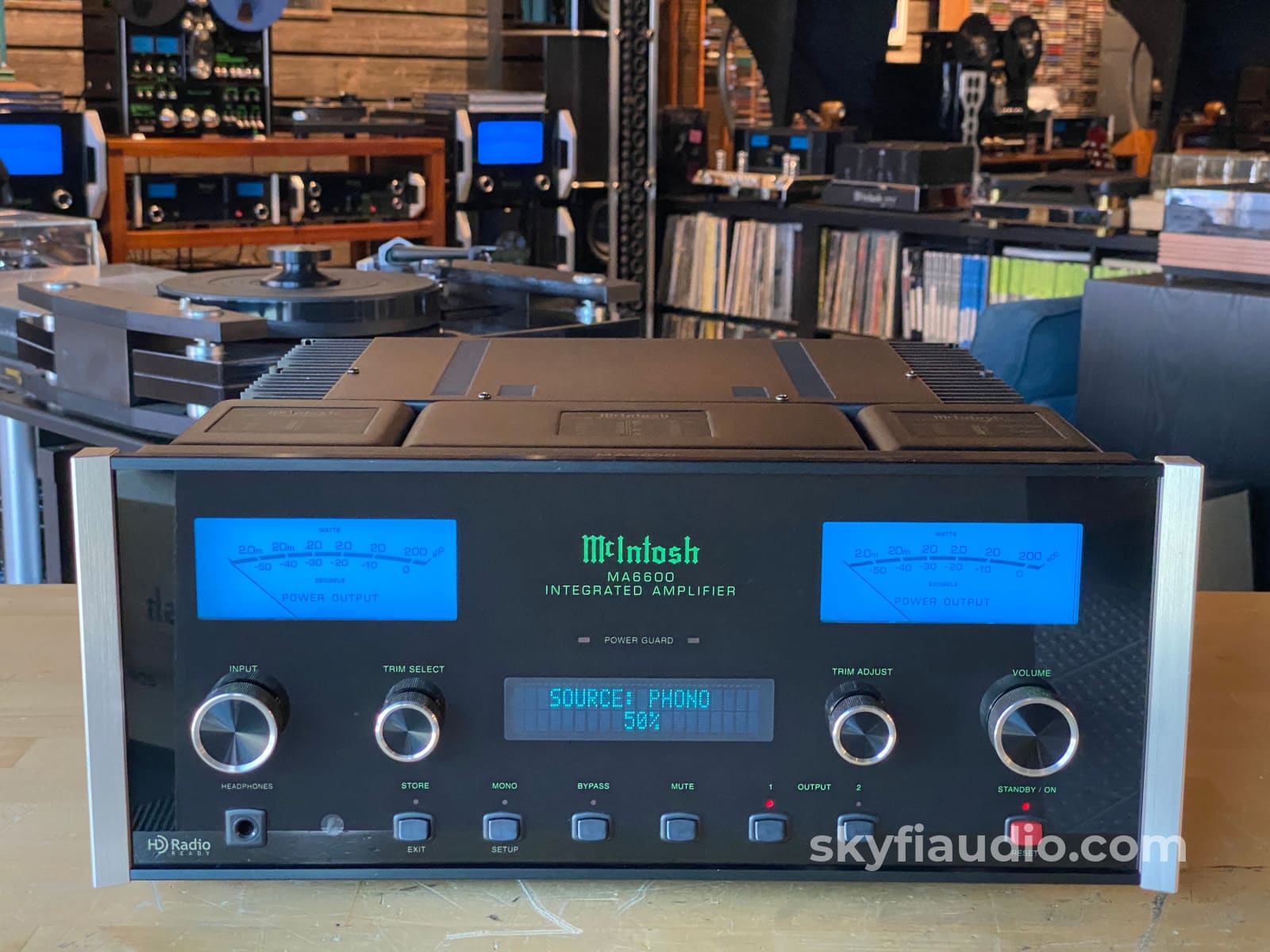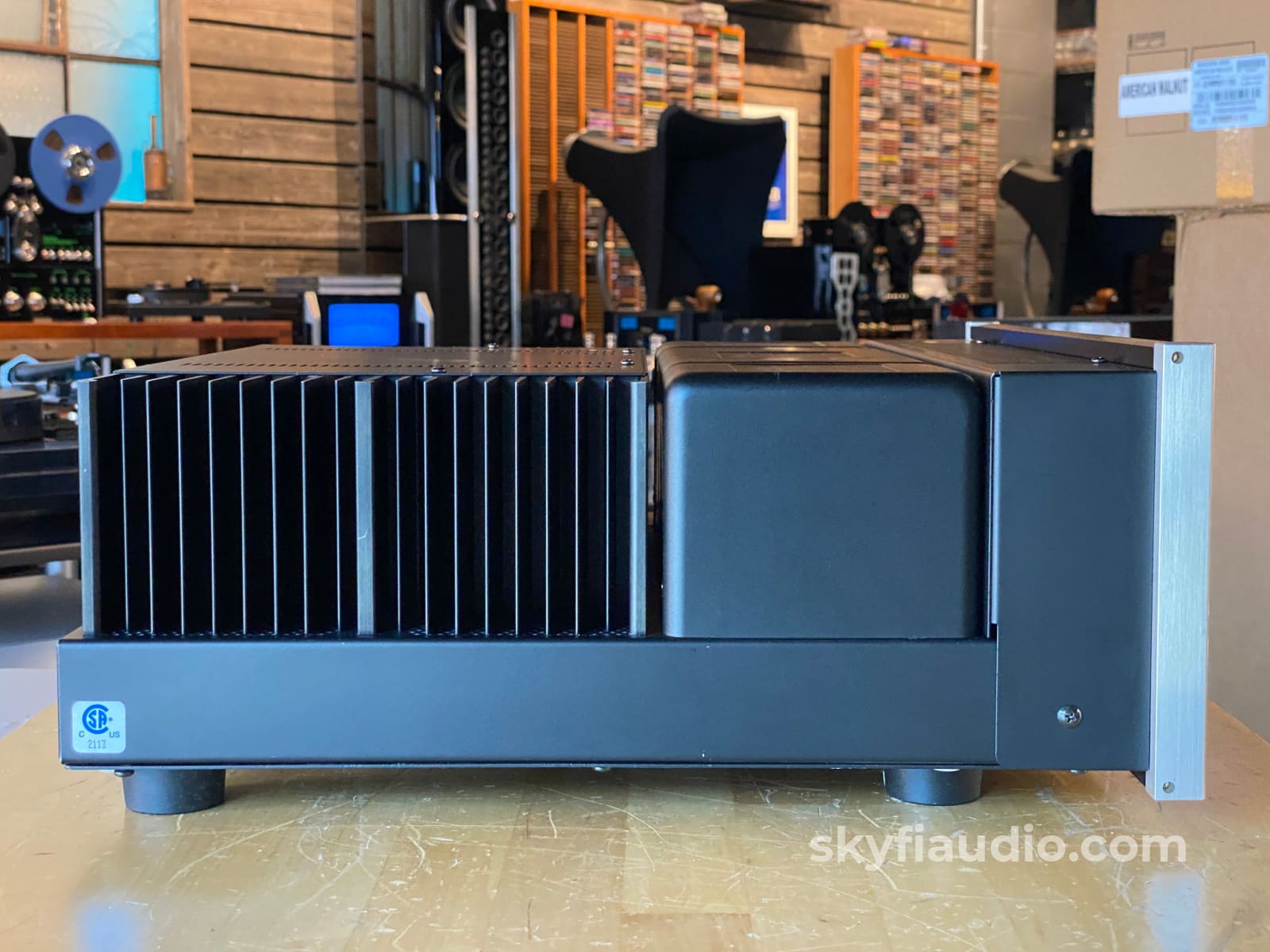
















McIntosh MA6600 Receiver with TM2 HD AM/FM Tuner Module
Free Shipping on *ALL* Electronics (Excluding Speakers, Contiguous 48 US States Only)
Pickup currently unavailable at SkyFi 479

McIntosh MA6600 Receiver with TM2 HD AM/FM Tuner Module
SkyFi 479
479 South Broad Street
Glen Rock NJ 07452
United States
General:
Great integrated from McIntosh built just before they started including DACs in all their models. This one won't be outdated anytime soon.
This MA6600 also has the McIntosh TM2 HD AM/FM tuner module installed, an option rarely seen which technically makes this unit a receiver.
Some of the best features include balanced CD inputs and jumpers for the pre-power sections, allowing you to turn this into a great preamp one day if you decide to go the separate amplifier route.
A comparable model today, the MAC7200 will set you back $8000.
Unlike smaller integrated amps, the MA6600 features the glorious output transformers which McIntosh is known for that deliver their smooth warm sound we have come to love over the decades. Also benefits from all the McIntosh patented technologies like Power Guard and Sentry Monitoring which keep their amps lasting a lifetime.
You'll also notice in one of our internal pictures that this model utilizes the fiber optic lighting system which delivers perfectly matched and even lighting throughout the faceplate. Earlier models utilized lamps which often burned out, and later models utilize many many LED's to get the same effect at a lower cost.
This is a complete set including the manual, remote, power cord, and heavy duty official McIntosh double box with a plywood base and McIntosh RAA2 External AM antenna. We ordered a fresh new model remote from McIntosh which is much more stylish and pleasurable to use than the HR070 this originally shipped with.
As with all our McIntosh products, this will ship in an authentic McIntosh double box with plywood base for safe transport. The only safe way to ship these heavy monsters.
McIntosh Performance Features:
• Power Output with Patented Autoformer
The MA6600 consists of a 200 watts per channel stereo Power Amplifier with less than 0.005% distortion. The McIntosh designed and manufactured Autoformer allows connection of 2, 4 or 8 ohm Loudspeakers. The Power Amplifier uses Thermal Trak1 Output Transistors for lower distortion and cool operation.
• Electronic Switching and Balanced Connections
The Preamplifier uses Logic Circuits controlling Electromagnetic Switches on all inputs and operating functions for reliable, noiseless, distortion free switching. There is a Balanced Input for connection of source components.
• Power Guard
The patented McIntosh Power Guard circuit prevents amplifier clipping and protects your valuable Loudspeakers.
• Special Power Supply
The large Power Transformer, multiple filter capacitors with 100 Jules of Energy Storage and regulated Power Supply ensures stable noise free operation even though the power line varies.
Brand Background:
McIntosh Laboratory is an American manufacturer of handcrafted high-end audio equipment based in Binghamton, New York. The company was founded in 1949 by Frank McIntosh. The company designs and produces audio amplifiers, stereo tuners and other consumer electronics products.
Ownership:
Single Owner
General Sound:
Big beautiful musical sound with little fatigue.
Cosmetic Condition:
7/10 = Good. One or two minor scratches. Well Maintained. See our detailed rating description here.
Working Condition:
Working perfectly and tested in our lab and listening room.
Included:
Unit, remote, manual, McIntosh shipping carton, and power cord.
Packing:
Original Manufacturers Packing
Specs:
Output Load Impedance
2, 4 or 8 ohms
Rated Power Band
20Hz to 20,000Hz
Total Harmonic Distortion
0.005% maximum with both channels operating from 250 milliwatts to rated power, 20Hz to 20,000Hz
Dynamic Headroom
2.0dB
Frequency Response
+0, -0.5dB from 20Hz to 20,000Hz
+0, -3dB from 10Hz to 100,000Hz
Preamplifier Output 1 and 2 (for rated input)
1.4V unbalanced (8V Maximun)
Sensitivity (for rated output)
High Level, 250mV unbalanced, 500mV balanced
Phono, 2.5 mV
Power Amp In, 1.4V
Signal To Noise Ratio (A-Weighted)
High Level, 92dB below rated output
Phono, 84dB below 5mV input
Power Amplifier, 115 below rated output
Intermodulation Distortion
0.005% maximum, if the instantaneous peak power is 400 watts or less per channel with both channels operating for any combination of frequencies from 20Hz to 20,000Hz
Wide Band Damping Factor
Greater than 40
Input Impedance
High Level, 20K ohms
Phono, 47K ohms; 65pF
Power Amp In, 10K ohms
Maximum Input Signal
High Level, 8V unbalanced, 16V balanced
Phono, 80mV
Power Amplifier In, 16V
Preamplifier Output Impedance
220 ohms
Power Guard
Less than 2% THD with up to 16dB overdrive at 1,000Hz
Voltage Gain
High Level to Rec Output: 0dB
High Level to Output 1 and 2: 15dB
Phono to Rec Output: 40dB
Phono to Output 1 and 2: 55dB
Power Amplifier: 29dB
Tone Controls
Bass Control ±12dB (1dB steps) @ 30Hz
Treble Control ±12dB (1dB steps) @ 10,000Hz
Dimensions:
Overall Dimensions
Width is 17-1/2 inches (44.45cm)
Height is 7-5/8 inches (19.37cm) including feet
Depth is 22 inches (55.88cm) including the Front Panel, Knobs and Cables
Shipping Carton Dimensions
Width is 29-1/2 inches (74.93cm)
Depth is 29 inches (73.66cm)
Height is 17 inches (43.18cm)
Weight:
74 lbs.
Link to MA6600 Receiver Manual:
Click Here
Link to TM2 HD AM/FM Tuner Module Manual:
Click Here
Recommended Cables:
Kimber Kable - RCA Interconnects - Better
Kimber Kable - RCA Interconnects - Best
Kimber Kable - Phono Interconnects - Better
Kimber Kable - Flagship Phono Interconnects - Best
Kimber Kable - BALANCED XLR Connectors - Better
Kimber Kable - BALANCED XLR Connectors - Best
Kimber Kable - Power Cords - Better
Kimber Kable - Power Cords - Best
The SkyFi Testing Process for Stereo Receivers:
We start with a visual inspection of all internal components to make sure that there are no signs of heat stress or damage. Capacitors are checked for telltale signs of predictive failure including bulging, shrunken wrappers, or physical leakage. We also inspect the PCBs for discoloration from resistors or transistors that may have been running hot. On vintage units we often spot check select capacitors for value and ESR.
If the device has the ability to decouple the preamplifier from the power amplifier, we remove the jumpers and independently test each section. If the device cannot be decoupled, we assess the electronic condition of the piece by analyzing the speaker level output only.
We start by connecting the “preout” jacks of the receiver to a Sencore PA81 Power Analyzer which simulates real world loading conditions and gives us an oscilloscope interface. The first order of business is checking that the volume control works smoothly throughout its entire range with acceptable channel balance. This is accomplished by feeding a 1KHz sine wave into one of the preamp’s line level inputs while monitoring the preamp’s output on an oscilloscope. We then switch to a 1KHz square wave to test the tone controls, loudness function, and filters where applicable. During this step we are watching for equal alteration of the test signal by both channels. This also helps us identify dirty controls that will need treatment. Once the basic line stage functions are verified, we test each input individually. This is especially important for devices that use relays to select their sources.
If the preamp section is equipped with a phono stage we test that as well. We use an inverse RIAA filter which allows us to feed a reference test signal into the phono input with the proper RIAA equalization and level. A square wave or sine sweep is used to verify that the device’s phono stage is faithfully reproducing the RIAA curve.
To test the tuner, we connect one of the tape outputs to the Sencore PA81 and the antenna terminals to a Sencore SG80 which allows us to “simulate” an ideal radio station using precision test signals instead of music. This device, in conjunction with an oscilloscope allows us to properly evaluate the following parameters:
- AM Reception (Where Applicable)
- FM Mono Reception & Tuning Meter Function
- FM MPX Reception (Stereo)
- Dial Tracking - How accurately the tuner dial or display indicates the actual frequency of the broadcast being received.
- Stereo Separation - A properly working stereo tuner will have minimal crosstalk between the left and right channel.
- Sensitivity & Signal Strength Meter Function - By lowering the output of the SG80 we can simulate weak stations and determine how well the tuner will be able to pull in weak distant stations. This adjustment also helps us verify signal strength meter function.
If the tuner has acceptable performance related to the parameters above, we connect the unit for listening tests with a simple dipole antenna. We listen for audio reproduction quality of local stations and evaluate how many stations the tuner can receive while we sweep through the dial. We are looking to verify that the tuner can decode stereo on strong local broadcasts and pick up a wide variety of local stations at the bottom, middle, and top of the frequency band. At this point we also test convenience features such as muting, filters, built in oscilloscope function, etc.
Next, we test the power amplifier section by connecting the receiver’s speaker outputs to a Sencore PA81 Power Analyzer which acts as a dummy load, DC offset monitor, and oscilloscope interface. We start with a low level 1KHz test signal at the “main in” jacks and slowly increase its amplitude while monitoring the output on an oscilloscope for signs of noise, clipping, distortion, or improper channel balance. We continue increasing the signal level until the amplifier reaches clipping. At this point we take an output power measurement and compare it to the spec sheet of the amplifier to verify proper performance.We finish off the bench evaluation with a 1KHz square wave check and a 20Hz to 20KHz sine sweep to assess the amplifier’s frequency response characteristics. This battery of tests will usually reveal if the amplifier has any issues that need further attention.
If the preamp and power amp both pass these tests, we reconnect the sections and verify that the preamp section can drive the power amp to rated power with a 1KHz tone on one of the line level inputs.
Before the device leaves the bench, we perform a listening test with actual music using a variety of preferred test tracks. Our benches are outfitted with familiar monitor speakers which help us identify inconsistencies that will not always show up on our test gear. The main things that we are listening for are hum or noise with no signal present, proper center image, clicks, pops, or any other obvious undesirable audio characteristics.
If the unit passes all of these tests it is moved to our long term testing rig where we simulate real word operating conditions for 6-8 hours. This allows us to monitor the unit for signs of thermal runaway or intermittent issues that only crop up when the unit has fully come up to temperature.
Choose options

















